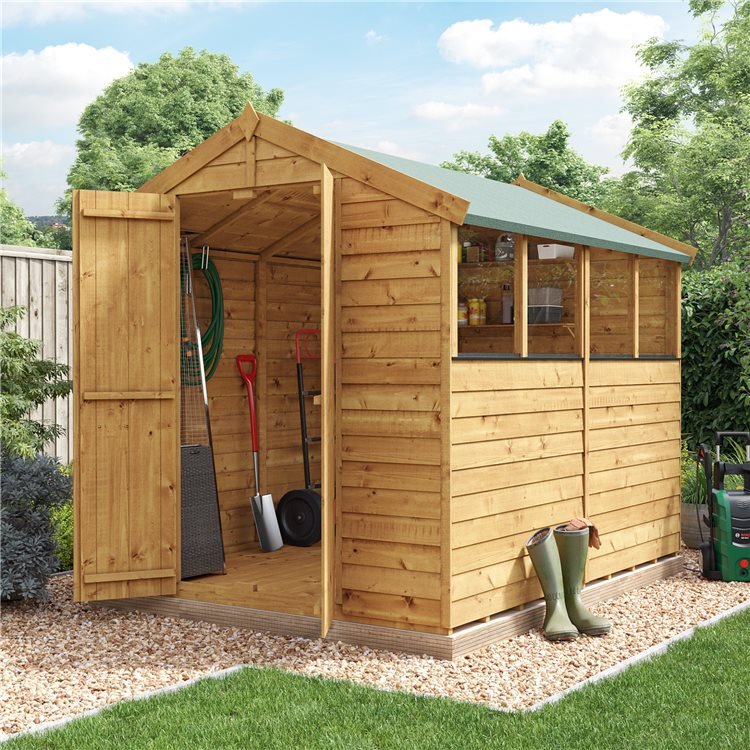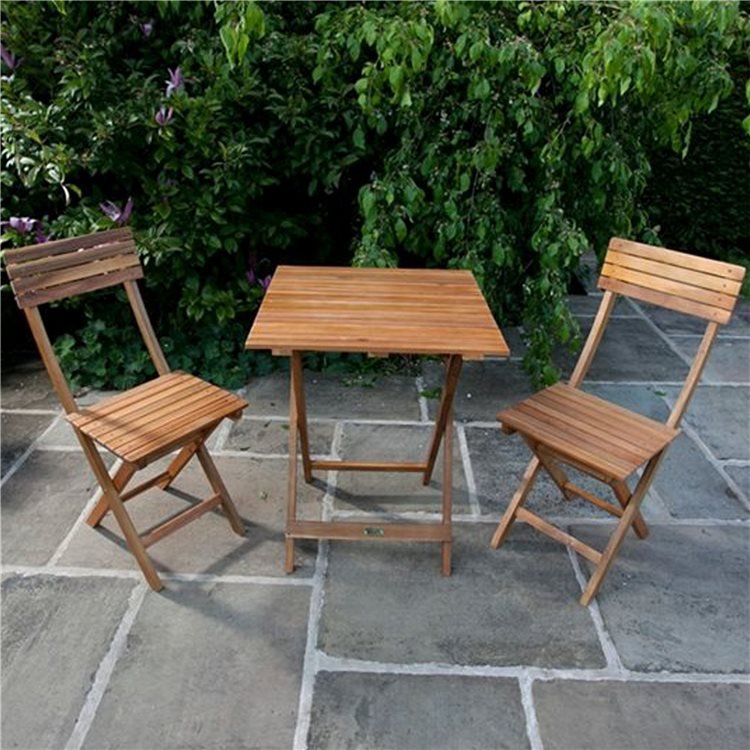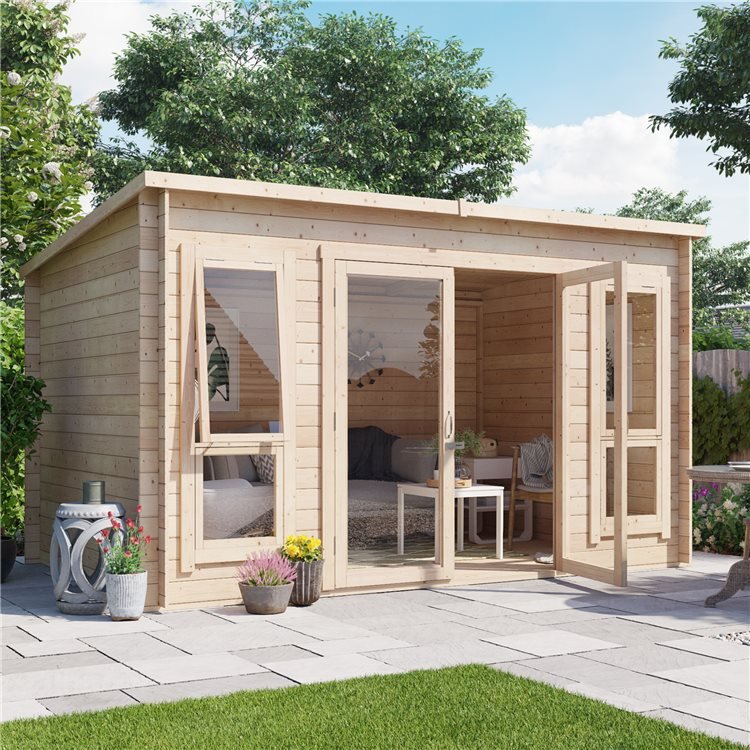Jump to:
Gardening can be one of the healthiest and most rewarding activities around the house, so it is not surprising that so many people find it enjoyable. But maintenance and repairs are standard procedures to keep it looking fresh, healthy, and pest-free. This especially applies to Garden Buildings like sheds and log cabins which receive constant exposure to the unreliable British weather.
Environmental factors like rain, wind and temperature changes, as well as pets and other animal species, can create signs of wear. In addition, buildups of dust, moss, algae, dirt, mud, and similar can alter its appearance and even permanently damage it in some cases.
Luckily, those are reversible when approached in a timely manner with the right tools. One of those is a pressure washer that will do an excellent job cleaning those buildings and fully restoring their beauty – especially when you follow it up with a paint job. Let’s find out how.
(Image Credit: Wikimedia)
When is it safe to pressure wash garden buildings?
A pressure washer is a very robust tool made for cleaning various surfaces. However, it is commonly used for cleaning farm equipment, buildings, or roads. However, it also provides exceptional results when cleaning driveways, patios, house walls, and other surfaces around the house.
PSI (pressure per square inch) and GPM (gallons per minute) determine its use and capacity. These numbers will indicate the amount of water that flows through the house per minute and how intense that water’s pressure is.
Pressure washers with more PSI and GPM are great for cleaning robust surfaces, but some materials may get damaged in the process. Materials like wood, aluminum, vinyl, and similar can still be pressure washed, but cautiously to avoid damaging them.
It is safe to pressure wash garden buildings when the pressure of the pressure washer is between 1200-2400 PSI, with proper nozzle selection.
Using a pressure washer with a PSI of less than 1200 will make the job lengthy and defeat the purpose of using it ahead of some standard methods like cleaning with a garden house. On the other hand, more pressure than that can damage the garden building, so you should avoid it.
Electric pressure washers usually operate between 1200 and 1900 PSI. On the other hand, gas pressure washers are stronger and operate at 2000 to 2800 PSI. When taking this into consideration, both variants can work perfectly for this particular purpose.
Furthermore, you need to use the correct nozzle for these materials. Pressure washers usually come with a few different nozzle tips:
- 0°
- 15°
- 25°
- 40°
- 65°
The higher the number, the more spread the hose will have; hence the pressure will be weaker. The 0° nozzle is the strongest with the lowest spread, making it a good option for spot-treating certain stains. However, using it on softer materials like wood or aluminum will almost always penetrate the surface, so you should not use it when cleaning garden buildings. The 65° nozzle is the mildest, often used for applying and rinsing pressure washer soap.
For cleaning your garden furniture, you should stick to the mid-range. The 25° nozzle is used most often for various jobs and purposes, which also applies to garden buildings. Of course, you can switch it to 15° or 40° nozzles for sturdier or more fragile areas, but the 25° should be ideal for most surfaces.
How to pressure wash garden buildings?
Some of the most common garden buildings are:
- Log Cabins
- Summerhouses
- Garden offices
- Sheds
- Greenhouses
Garden Log Cabins are made of robust, interlocking Log Boards. These boards are usually thick and should be able to withstand pressure washing in the mentioned 1200-2400 PSI power setting. However, the roof felting or shingles will be much more sensitive and should not be pressure washed under any circumstances.
In a similar vein, a summer house is also made from interlocking wooden cladding, although it may be thinner and weaker than those used in Log Cabins. It’s a good idea check the thickness of the timber before proceeding to pressure wash to avoid damaging the wood.
While we build our range using timber, Garden offices can be built using various materials. Therefore, it is vital to examine its craft to determine whether it is safe to pressure wash it, but the answer will be affirmative in most cases.
Sheds can also be built using a variety of materials. It can be an all-wood construction or, alternatively, be built from metal or plastic. There are multiple combinations of these materials, but luckily, you can pressure wash every one of them.
Greenhouses fall in the “if” category, as some materials can or can not be pressure washed. For example, it is very common for a greenhouse to be made up of polyethylene plastic sheet, which is very thin, making it impossible to pressure wash without damaging it. However, glass window-covered greenhouses should withstand the pressure with ease.
Should I use detergent when pressure washing garden buildings?
Detergent is absolutely fine to use to accompany the pressure washing process, as it can provide a shinier finish and a more thorough cleaning. Just make sure you use an appropriate detergent suited for the surface you are cleaning.
Many options are on the market, including detergents made for wood, cement, windows, and all-purpose pressure-washing detergents. In addition, only use detergents made for pressure washers. Many detergents can contain ingredients harmful to the tool, which makes them unsafe and should not be used under any circumstances.
Can I pressure wash outdoor furniture?
Many outside buildings contain outside furniture, such as benches, tables, chairs, and similar. It is entirely safe to pressure wash them, too, as long as they are made up of the previously mentioned materials.
Some exemptions exist, such as stained wood furniture or table glass covers. They can get damaged from pressure washing, so those should be avoided. For others, as long as you use a 25° or 40° nozzle tip on a pressure washer between 1200 and 2400 PSI, you will be good to go.
What are the benefits of pressure-washing garden buildings?
Garden buildings need cleaning every once in a while, and doing it with a pressure washer is by far the most convenient choice. It saves time and money, as it is a lot more efficient compared to cleaning them with garden hoses, cloths, and similar methods. Furthermore, paying for those services can be costly and accumulate over time, creating even more significant expenses.
In addition, pressure washing will keep the surfaces fresh for prolonged periods, making it an excellent strategy for pest control and preserving them from rotting or decaying.
Finally, pressure washing is environmentally safe, as water expenditure is significantly lower than garden hoses, for example, and most pressure washer detergents are biodegradable and eco-friendly.
In summary
A pressure washer is a potent and resourceful tool that will make almost any cleaning job effortless. It is simple to use and a great way to save time and money for around-the-house cleaning jobs.
Due to its power, it can injure you or damage the item you are cleaning, so you should always be careful when operating a pressure washer. And remember not to go overboard with cleaning your garden buildings – once per year is sufficient for thorough cleaning while not damaging any of the structures.
But when used properly, with the needed safety measures, a pressure washer is completely safe and efficient for cleaning and preserving the lifespan of your garden buildings.
If you’ve been reading this without a building of your own to clean, you can click the button below to start browsing and find one right for you!
Shop Garden Buildings







